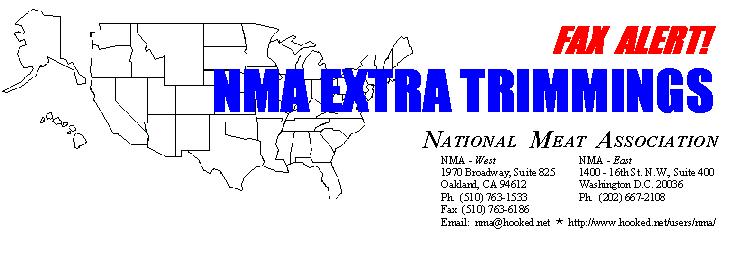

To: NMA Members
Fr: Rosemary Mucklow, NMA Executive Director
Re: Lessons from Hudson August 25, 1997
You�ve all heard and read a great deal about the Hudson recall. The purpose of this Fax Alert is to provide guidance to members on preventive steps that they may wish to consider to limit exposure in a recall situation.
Documentation.
1. Records to identify product source by production lots.
Some firms have several production lines that operate simultaneously, but use different source materials. For instance, a low fat/soy added line may have dedicated source materials different from other regular lines, or from lines that are dedicated to a single customer with specs. The better the records, the more limited a recall or market withdrawal will be.
2. Records to show where rework was used, especially if it re-enters the general production system.
The practice of holding rework to the next day simply extends the definition of today�s lot through the next day, because of product co-mingling. The Hudson lesson is that if this is an on-going practice, you implicate everything in the market because there is linkage of the problem lot with everything the company produces following it, no matter how infinitesimal the link. Each firm will work out the system that fits its needs best; one way is to use the re-work at the end of the shift, rather than hold it over. If there is no alternative to hold-over, then it would be best to handle it at the end of the second day�s shift so that any problem with the prior day�s production would not be linked to the second day�s main production.
In the event that wholesome product is returned in a large quantity to the plant (out of spec, etc.), it is recommended that it be given both a physical and microbiological examination before it is reworked. Again, a substantial quantity should be handled after a regular shift�s production.
3. Records to show a complete break in the production system.
USDA�s present definition of a lot for the purpose of recall/market withdrawal is "clean-up to clean-up." FSIS� Deputy Administrator for Field Operations Dr. Mark Mina, responding to questions at NMA�s Food Safety & Regulatory Committee meeting last week, said that the Agency would consider proposals to reduce lot size but would be looking for elements to demonstrate a complete break in the production system.
Managing the Crisis
It is essential that someone who knows the operation of the business be designated as the Crisis Manager, be on site at the location and authorized to speak for the company with the USDA and other legitimate inquirers at all times, and to find and have the authority to provide records as requested. There should be a second person designated to respond to media inquiries. Sometimes the Crisis Manager will serve in both of these roles, or the firm will retain an outside PR firm.
NMA has a resource available about dealing with a crisis which is available to NMA members by fax on request.
Finally, NMA will be establishing a Crisis Management Hot Line which will provide a 24-hour number for members to call to obtain access to NMA staff, professionals and consultants in the event that the member has a crisis and needs immediate assistance and guidance. We expect to have this set up by September 1.
Go to NMA EXTRA TRIMMINGS 8/26
�